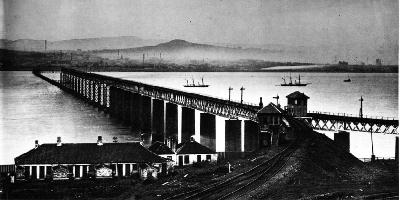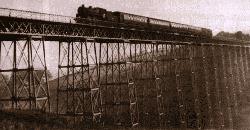At approximately 7:15 p.m. on the stormy night of 28 December 1879, the central navigation spans of the Tay bridge collapsed into the Firth of Tay at Dundee, taking with them a train, 6 carriages and 75 souls to their fate.

At the time, a gale estimated at Beaufort force 10/11 was blowing down the Tay estuary at right angles to the bridge. The collapse of the bridge, only opened 19 months and passed safe by the Board of Trade, sent shock waves through the Victorian engineering profession and general public.
The disaster is one of the most famous bridge failures and to date it is still one of the worst structural engineering failures in the British Isles. Detailed accounts of the disaster are given by Prebble(1) and Thomas(2). A fully revised new edition of David Swinfen’s(3) book on the disaster was published in 2016. The book, utilising recent research, addresses the questions: What caused the disaster and who was to blame. In addition, it examines the question of how many lives were lost.
The first Tay rail bridge was completed in February 1878 to the design of Thomas Bouch. Bouch was responsible for the design, construction and maintenance of the bridge. Most of his bridges were lattice girders supported on slender cast iron columns braced with wrought iron struts and ties, such as the Belah Viaduct in the photograph to the right. The building of the Tay bridge culminated in him being knighted. A modern account of the life and work of Bouch is by Rapley(17)

The Tay bridge was nearly two miles long, consisting of 85 spans and at the time was the longest bridge in the world. The spans carried a single rail track; 72 of these were supported on spanning girders below the level of the track; the remaining 13 navigation spans were spanning girders above the level of the track (i.e. the train runs through a tunnel of girders).
These “high girders”, as they were known, were 27 ft high with an 88 ft clearance above the high water mark. It was these spans which fell. Most of the girders below track level, all of which remained standing, were transferred to the present Tay rail bridge(7). At the time of the collapse Bouch was working on the design of the proposed Forth Bridge. In consequence, the design of the bridge was transferred to Benjamin Baker and Sir John Fowler.
A Court of Inquiry was set up to try and ascertain the reason for the collapse of the bridge. The Court of Inquiry report (8) concluded that, “The fall of the bridge was occasioned by the insufficiency of the cross bracing and its fastenings to sustain the force of the gale.” The Court of Inquiry indicated that if the piers, and in particular the wind bracing, had been properly constructed and maintained, the bridge could have withstood the storm that night, albeit with a low factor of safety – 4 to 5 was the norm at the time.
Sir Thomas Bouch was held chiefly to blame for the collapse in not making adequate allowance for wind loading. He used a wind pressure of 10 lbsf/sq ft for the design of the Tay bridge. It is interesting to note that when working on the design of a proposed Forth bridge (1866) he used 30lbsf/sq ft(6). To this day, however, there is still speculation as to the fundamental cause and as to whether the designer, Thomas Bouch, was to blame. A very readable account of the transcripts of the public enquiry is by Gren(18)

Apart from the results of the original Court of Inquiry, various theories have been put proposed to explain the collapse. The picture shows the present Tay Rail bridge alongside the pier remains of Bouch’s bridge. It is a very emotive site and provides a grim reminder of the disaster. The wrought iron girders which remained standing after the disaster were transferred onto the present bridge where they are still in use today.
Researching the Tay bridge disaster has taken place over a period of 18 years resulting in 4 joint papers being published, three of which are available for download from the References section below. For further information, please email: tmartin1879@hotmail.com
References
1. Prebble J. (1979) The High Girders. Penguin.
2. Thomas J. (1970) The Tay Bridge Disaster David and Charles, Newton Abbot.
3. Swinfen D. (2016) The fall of the Tay Bridge, Birlinn Ltd.
4. Martin T. J. MacLeod I. A. (1990) The Tay Bridge Disaster – a study in structural pathology, Developments in Structural Engineering, Forth Rail Bridge Centenary Conference, Spon.
5. Martin T. J & MacLeod I. A. The Tay rail bridge disaster – A reappraisal based on modern analysis methods, Proc. Instn Civ. Engrs, 1995 ,108, 77-83
6. Paxton R. (1990) 100 years of the Forth Bridge, Thomas Telford, London
7. Paxton R. & Leslie J. Bright Lights, The Stevenson Engineers 1751-1971
8. Shipway J. S. (1989) Tay rail bridge centenary – some notes on its construction 1882-87 Proc. Instn Civ. Engrs Part 1, 86, Dec., 1089-1109
9. Court of Inquiry (1880) Report upon the circumstances attending the fall of a portion of the Tay Bridge.
10. Dow W. M. (1979) ‘Destined for disaster’, Scots Magazine, 275-186.
11. Lewis R. P. & Reynolds K. (2002) Forensic Engineering: A Reappraisal of the Tay Bridge Disaster, reinvestigating the Tay Bridge disaster of 1879, Interdisciplinary Science Reviews, Vol 27, no 4.
12. Lewis R. P. (2004) Tempus Publishing, Beautiful railway bridge of the silvery Tay. Reinvestigating the Tay Bridge disaster of 1879.
13. McKean C. (2006) Granta publications, Battle for the North, The Tay and Forth Bridges and the 19th -Century Railway Wars.
14. Burt P. J. A. (2004) The great storm and the fall of the First Tay Bridge, Weather, Vol 59, no 12.
15. Martin T. J & MacLeod I. A. The Tay rail bridge disaster revisited, Proc. Instn Civ. Engrs, 2004 ,157, 187-192
16. Cameron S. (2002), Colourpoint Books, Death in the North Channel: The Loss of the “Princess Victoria”, January 1953,
17. Rapley J. (2007), Tempus Publishing, Thomas Bouch, the builder of the Tay Bridge.
18. Gren Andre (2006) Siver Link Publishing, The Bridge is Down: The Tay Bridge Disaster of 1879 as Reported in transcripts of the Public Enquiry.
19. Lumley Robin (2013) The History Press. Tay Bridge Disaster: The People’s Story.
20. Martin T. J & MacLeod I. A. The legacy of the Tay Bridge collapse, ISIS Journal of Engineering Vol. 157.2018 ,108, 27-31
21. Colin R. Gagg & Peter Lewis. (2011) The rise and fall of cast iron in Victorian structures: a case study review. Engineering Failure Analysis, 18(8) pp. 1963-1980.
22. Angus H. Cast Iron: physical and engineering properties . 2nd ed. Butterworth; 1976.
23. Bjorn Akesson Understanding bridge collapses Taylor & Francis Group, London, UK; 2008
24. Robert S. Shiels A Conflict of Interest at the Tay Bridge Disaster Inquiry (2022) Northern Scotland vol. 13(2), pp.213-6
25. Robert S. Shiels Civil litigation and the construction of the new Tay Bridge, Scottish Law Agents 2024 17
26. Robert S. Shiels The Tay Bridge disaster and the major personal injury claim Reparation Bulletin 2015, 122(Feb), 4-7
27. Robert S. Shiels The investigation of sudden deaths and the Tay Bridge disaster of 1879 Juridical Review 2016, 3…
28. Robert S. Shiels Scots law and the Tay Bridge disaster of 1879 Scots Law Times 2013, 40 , 271-274
Permission to reproduce the paper: Martin T. J & MacLeod I. A. The Tay rail bridge disaster – A reappraisal based on modern analysis methods, Proc. Instn Civ. Engrs, 1995 ,108, 77-83 in PDF format from the Institution of Civil Engineers is gratefully acknowledged.
Permission to reproduce the paper: Martin T. J & MacLeod I. A. The Tay rail bridge disaster revisited, Proc. Instn Civ. Engrs, 2004 ,157, 187-192 in PDF format from the Institution of Civil Engineers is gratefully acknowledged.
Permission to reproduce a pier image (showing uplift) from the Dundee City Council, Central Library, Photographic Collection is gratefully acknowledged.
Permission to reproduce clips from the podcast “The riddle of the Tay Bridge disaster” from the Open University is gratefully acknowledged.
Permission to reproduce 2 pier images from Dr. P. R. Lewis Associates is gratefully acknowledged.